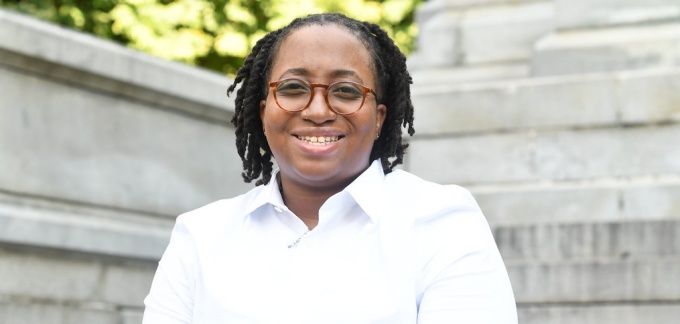
Deja Graham '24, editor in chief of the Buffalo Human Rights Law Review
Breaking down the roots of school segregation
Nearly 70 years after Brown v. Board of Education and nearly 60 years after passage of the Civil Rights Act, American schools remain deeply segregated—more so than many people realize, writes third-year law student Deja Graham.
“The diversity issues that are seen in … professional fields start on the first day a child is enrolled in kindergarten,” Graham asserts in her article “The Forgotten: NYC and School Segregation,” just published in the Buffalo Human Rights Law Review. “The chances of a Black or brown child achieving success decrease with every year they continue to receive a separate and unequal education.”
The 24-page article, written last year, grew out of Graham’s experience in Professor Samantha Barbas’ class on 20th century American legal history. “I came into the semester knowing I wanted to write about this,” she says, “but my focus did not start out as narrow as it is in the article.” Graham, a Queens native and a graduate of its public school system, zeroed in on New York City schools as emblematic of the stubborn problem of school segregation nationwide.
Professor Heather Abraham is Graham’s supervising attorney in the law school’s Civil Rights and Transparency Clinic, where Graham is working on segregation-related impact litigation, representing a group of civil rights nonprofit organizations. “When Deja approached me about this topic, I was thrilled,” Abraham says. “Regrettably, segregation in schools, neighborhoods and throughout our society remains a timely public challenge. Her passion, based on life experience and her career interests, shines through in her research and writing.”
Graham, who’s now editor in chief of the Buffalo Human Rights Law Review, took time out from her 3L responsibilities to talk about the article and its import.
How did your personal experience in the New York City public school system inform your work on this article?
It was very jarring doing the research, because there were a lot of things I didn’t know. Hindsight is 20/20, and now I recognize that in my high school—which had 3,000 students and only one white student—something was wrong. New York City is the worst place to attend school as a Black person, in terms of segregation, and the second-worst as a Latinx person. The idea that school segregation is still occurring is not widely recognized.
You write about the downstream effects of de facto school segregation, such as the lack of diversity in professions including law. Why did you think it was important to highlight these effects?
Why is it that only five percent of attorneys are Black? I get annoyed at hearing that question. It seems like the why is pretty obvious. School segregation is just one of many reasons why there’s a lack of representation in the legal field. You are more likely to obtain the education level that your parents obtained, so if the cycle continues, the higher the degree, the fewer Black and Latinx people.
Unless a wrench gets thrown into the cycle, it will never be fixed. Being in law school has made it clear to me that I defied the odds. Even outside of race, there’s a difference between a law student whose family has financial resources and one who has to work while in law school. There are so many layers to it.
You argue that only the federal government, not the states or the cities themselves, is in a position to eradicate school segregation. What could it do to accomplish this?
It’s a large issue in cities across the country. We need a more widespread way to address the problem, such as an act of Congress, to put forth a good-faith effort to try to address school segregation.
In doing the research for this it was clear that the responsibility has always been on the students to pick themselves by their bootstraps, but there’s no acknowledgment of the things that stand in their way and make it harder to succeed. I just wanted to put it on people’s radar that this is an issue.
Neighborhoods, at the time, were separated by distinct racial lines. As such, this loophole made the Civil Rights Act ineffective in tackling the desegregation of schools. For the government to intervene under Title IV, there must be an action by a school board that imposed segregation of public schools. Segregation would continue unchecked as long as the school board did not take adverse action. The unique construct of Northern cities, and the racial imbalance loophole in Title IV, meant that segregation could remain in place even if the school board took no adverse action. Title IV of the Civil Rights Act acted as a blockade between states and the federal government in addressing the segregation of schools in the North. The lines drawn for school districts and neighborhoods allowed segregation to continue while the states technically remained compliant with Federal law."